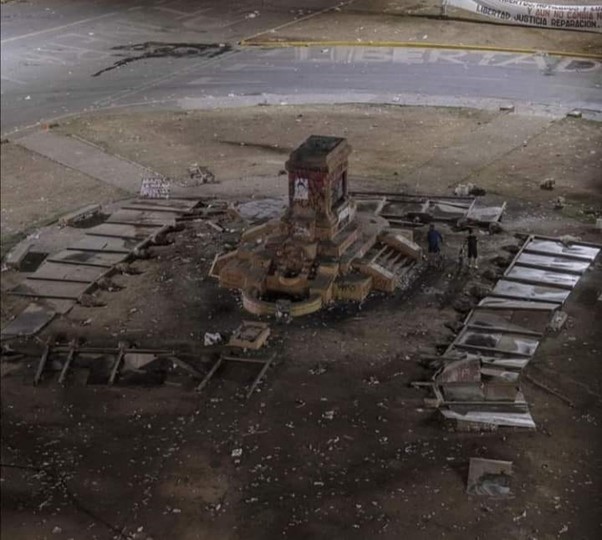
23/04/22
The performative power of determinate negation
Anthony McInneny
Plaza Baquedano was established in 1929 and replaced Plaza Italia which was named after a gift from the Italian Kingdom to Chile to celebrate the 1st centenary of the Republic of Chile. That monument gift is still located in Plaza Baquedano. Plaza Baqeudano is a more fitting name for the public space/monument that is the main place for public celebrations and demonstrations in Santiago, the capital of Chile. It is dedicated to General Manuel Baquedano who lead the Chilean Army to victory against the Peruvian-Bolivian alliance in the late 19C Pacific War. Plaza Baqedano, with the monument to General Baquedano by renowned sculptor Virginio Arias, also contained the unknown soldier’s remains from the Pacific War and the busiest Metro station in the Metropolitan network, Metro Baquedano. The urban insurrection, which began on 18 October 2019 with the arson attack on 20 Metro stations in 6 hours, is unrelenting, violent, and destructive. The decimation of the are within a 1 kilometre radius of Plaza Baquedona is entire. This área is called Ground Zero. The material damage in this área alone is 106 million USD. 80% of businesses are still protected behind welded sheet metal facades. The entrance to Metro Baquedano is permanently welded shut and the concourse is reduced to rubble, smashed up by hand with hammer and crowbar for missiles to throw at pólice. After the attempts to topple the monument to General Baquedano were not successful, the last attempt on International Women’s Day 2021, the National Council of Monuments decided to remove the sculpture to protect it and placed a 3 meter high, welded sheet metal cube around the emptied plinth and the tomb of the unknown soldier that was able to withstand the impact of a vehicle traveling at 80 kilometers/hour. On the second anniversary of 18 October, the usual Friday night riots, arson, and looting that is now called traditional protest destroyed the metal wall. In consultation with the Armed Forces, the National Council of Monuments decided to exhume the remains of the unknown soldier for fear that they would be exhumed by the regular rioters now called political prisoners if they are arrested for such crimes. Supporters of this violence and destruction, including the recently elected President and former Student Protest Leader, not only are calling for an amnesty for all crimes committed since 18 October but want to rename Plaza Baquedano, Plaza de la Dignidad (Plaza of Dignity). This is a fitting name for the materialization of what Marxist Philosopher called the Power of Determinate Negation and which the Cultural Industry applauds as art activism, the art of protest.

14/06/21
Bratislava: a place of heavy air
Alejandra Rivera
Dirty, gray and full of graffiti tags, Bratislava’s post-soviet look carries an air of nostalgia and suffering which is not cleaned nor relieved yet. Architecture is a mix of 1970s to present buildings. Some modernist such as the inverted pyramid of the radio station, all the way back to medieval structures still incrusted within the city reminding us that even though Slovakia is a relatively new constituted country, its physical environment has a much longer history.
Like in other small European towns, the castles, government buildings or palaces -the elite- is literally above the people, in the highest hill or the highest part of the city like if overseeing the people… sometimes protecting them, sometimes controlling them.
One breathes heavy air in a city that still carries in the soul the weight of Nazi atrocities. It is common to find metal plaques around the city in memory of persons or families that were sent to concentration camps. There is one metal plaque of an artist called Adolf Frankl (ironically an Adolf), who, with some non-Jewish Slovaks, was arrested on September 28, 1944. Following a stay in the concentration camp in Sered, Slovakia, he was later deported to the extermination camp Auschwitz-Birkenau. Luckily, he was liberated and he survived. After his liberation he depicted his experiences in a collection of paintings and drawings called appropriately “Visions from the inferno”. The plaque reads: “through my works I’ve created a memorial for all nations of the world. No one, regardless of religion, race, or political conviction, should ever again suffer such -or similar- atrocities”. The Frankl family expresses their heartfelt gratitude to all who helped them and others, to survive the Holocaust.
I stopped to think at this outlook, from this place overseeing Bratislava, trying to image the scenes. Many buildings I saw, they keep constructing, keep progressing on the march of civilization… oh how very uncivilized -I thought- we still are as human beings who kill its own kind.